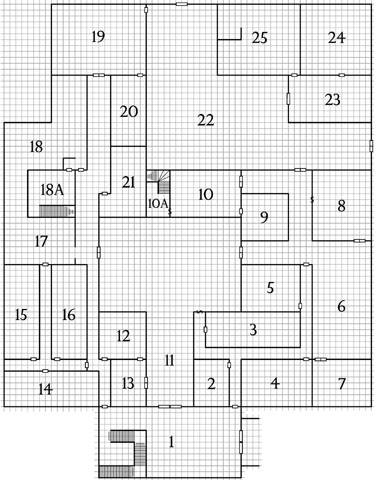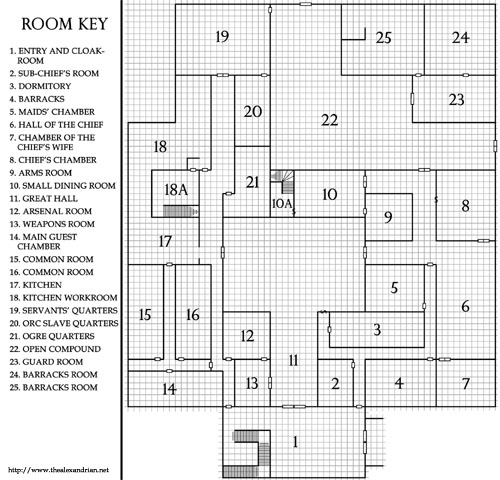Let’s step aside from the map itself for a moment and spend a moment talking about how the map is actually used at the gaming table. For reference I’m going to use this redrawn version of the map from G1 Steading of the Hill Giant Chief:

(The only substantial difference is that I haven’t included the fireplaces that appear on the original map.)
Imagine, for a moment, that your PCs have just entered area 22 on this map. You flip to page 5 of the module and check the key:
22. OPEN COMPOUND: 14 dire wolves run free here (HP 25, 23, 22, 2 x 10, 19, 3 x 18, 2 x 17, 15, 13, 12), and they will immediately attack any non-giant or non-ogre entering their area. Note that if they see the whip (room 19), however, they cower and make no sound, but otherwise they howl and bite!
Easy enough. What else might you want to know once the dire wolves start howling and biting?
We can probably start with, “Who might hear this?”
So we’d take a quick peek at neighboring rooms: 8, 10, 10A, 19, 20, 21, 23, and 25. Crap. Now I’m trying to look at multiple pages of the module simultaneously to figure out how, at a fundamental level, this compound “works”. In a lot of modules you can actually find yourself trying to look at a half dozen pages just to figure out everything that the PCs can actually see from a particular area.
The problem, of course, is that the map itself is largely a cipher: It’s a bunch of rooms, some doors, and some keyed numbers.
There are a lot of ways we could make it easier to figure out what we’re looking at. An easy one is to simply list a room key:
(click for a larger version)
Now I can tell in a glance that area 23 is the Guard Room (I’m guessing the dire wolves will attract some attention from there). Area 19 is a servants’ quarters (they’re unlikely to come out, but might flee out the other exit and down the hall looking for help; or maybe they’ll need to keep the orc slaves from area 20 in line if they start panicking).
And so forth.
Obviously this doesn’t entirely eliminate the need to reference the map key. But it does let us eliminate a lot of key references, cutting down on the page-flipping and allowing us to stay focused on the keyed information that’s most immediately important. This is particularly important when it comes to referencing important, non-localized information (the type of information we want about a location even when the PCs aren’t in that location).
What other non-localized information could be usefully pulled up onto the map?
Go to Part 7: The Monster Roster
This post is part of the RPG Blog Carnival for Cartography.















In the spirit of the “staged encounter” school of adventure design, I feel that you have no business trying to extrapolate who might hear what’s going on. If there are guards who might hear and join the dire wolves, then that is part of the dire wolf encounter and should be listed in the box. If it’s not there, you’re just adding trouble to your players that the adventure designer did not intend or balance the encounter for.
But in the spirit of the “you pays your money and you takes your chances” school, where guardrails are few and far between, adventure keys are not “encounters” so much as listings of what items and creatures of interest are present. It’s up to the GM to determine what happens based on the actions of the PCs. And since PCs are well known to be perverse devils that do not as a rule do what the GM expects, determining and addressing every possible (or even likely) interaction between encounter areas quickly becomes intractable.
Seriously, though, this is a philosophy of encounter design distinction that I think didn’t really even exist until 3rd edition came along (I never really looked at 2nd edition; I assume it was similar to AD&D in this, though). That’s not to say that designers wouldn’t/shouldn’t think about the expected party size/composition/strength that might be going through a particular adventure. But it really seems like in 3rd and especially 4th edition, there can be a real expectation on the part of the players that they won’t ever get in over their heads. IMO, that removes a lot of the tension (and hence, the fun) from the game. YMMV.
[OT note: I only just noticed you can resize the comment-entry box. Cool!]
I am running a 3rd party adventure in my game (Goodman Games’ Castle Whiterock) and I am going back and doing something like this — I’m generating a 1-page listing of keyed areas on each level, with a line or two for each describing generally what it is and what’s inside, for quick reference. Mainly because the flipping back and forth in the main adventure key to find stuff is a real pain. (I also copy stat blocks into a master list for reference, but I haven’t gotten all the kinks worked out of that yet.) I like the idea of combining this quick key with the map, actually, I may look into combining them myself. (Really I think my fundamental problem is too much paper and not enough space at the table.)
Good idea… in my dungeon maps I would probably just write the room name in the actual room, making it even simpler and eliminating the need to reference a chart and compare it to a room number. Might not always be possible of course, but where it is, that’s even better.
@Jack Colby: Absolutely. If you can make that work, go for it. One problem I usually run into is that there will be those one or two rooms which are too small for it, and then you end up with an inconsistent method.
I’ve also gotten used to the room key method because it’s a really easy improvement for published modules without having to fuss around with modifying the actual map.
I wonder if putting some form of symbol on the key to indicate if a room starts as occupied would be helpful. I think it might help the DM zero in on the most important rooms to consider if noise spills. I would also put information in the description of the room itself. Some modules have done this sporadically, but rarely with any consistency.
For me, what the rooms are isn’t important. If they have living creatures in them or noise, heat, or smells emanating from them is what I need to know during play.
What I do on my own maps is draw little figures and symbols.
As far as connecting the rooms to the module text, the numbering here seems pretty random. I mean, 1 leads to 11 or a hallway. Seems there should be a clearer way to do this.
I tend to draw furniture in my maps. It makes it easier to tell what the room is for, and to describe it on the fly (just need to jog my memory, as I’ve already pored over it to prep.) Also, there are reasons for critters to be in certain places, and that’s easier to remember.
My group averages 1 keyed area every 30 minutes of game time–it has become really pretty accurate measure. So I know that for a 5 hour session or a 10 hour session, our two main increments, I’m shooting for about 10 rooms or 20 rooms, give or take. Maps do not get beyond a certain size, and that helps.
As we consider the mega dungeon model, that shifts as they can go through areas faster if they’ve cleared them, know what was there, an how to get around. And, they can choose many different paths besides just one. So it remains helpful to think about how to organize lots of information on the map.